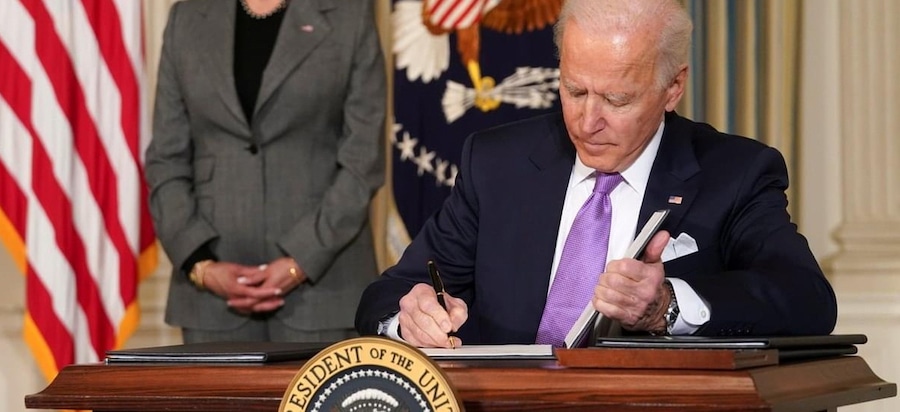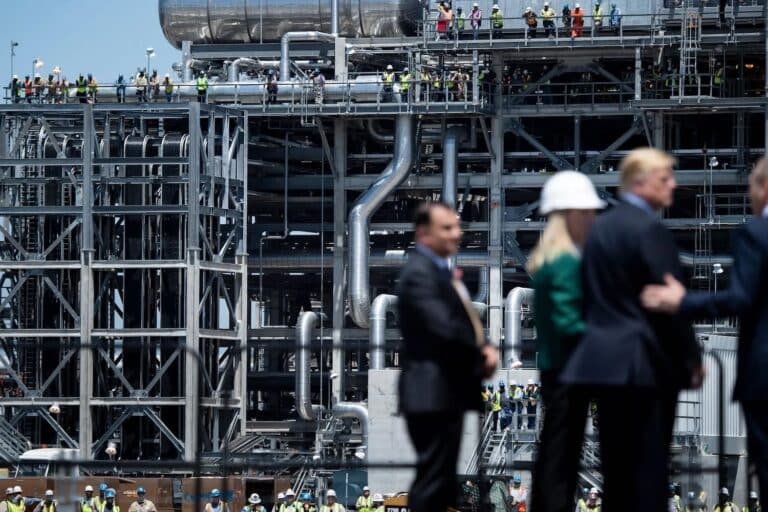China Halts U.S. LNG Imports Amid Tariff War
China has ceased importing liquefied natural gas from the United States since early February, as the ongoing tariff war impacts energy trade.
Current Access Level “I” – ID Only: CUID holders, alumni, and approved guests only
Insights from the Center on Global Energy Policy

In the first piece from CGEP’s new Energy Explained series, Dr. Melissa Lott explores the non-technological issues that threaten to keep the United States from achieving its near-term greenhouse gas emissions targets.
The Biden Administration has set the ambitious goal of reducing greenhouse gas (GHG) emissions in the United States 50-52 percent by 2030 below 2005 levels, the baseline year for comparison.[1] The country is making rapid progress toward this goal, thanks largely to cheap natural gas replacing coal as well as lower-cost wind turbines, solar panels, and batteries.[2] The incentives in the Inflation Reduction Act (IRA) will further drive down emissions. Still, the United States may fall short, but not due to a lack of low-carbon technology. It’s the non-technical barriers that could continue to get in the way.
Between 2005 and 2020, US GHG emissions (carbon dioxide equivalent) fell roughly 18 percent from nearly 7.5 to less than 6 billion metric tons. The biggest contributor to this drop was the power sector, as the country has increasingly shifted away from using coal to natural gas as well as solar, wind, and other renewables[3] to generate electricity. In multiple net-zero scenarios, zero-carbon electricity is consistently the backbone of a zero-carbon economy.[4] If the mix of grants, loans, rebates, incentives[5], and other investments in the IRA has its intended effect across the economy, including power plants, industry, transportation, and buildings[6], it could drive down emissions by an additional 10-18 percent, according to estimates.[7]
In other words, progress that appears to be largely baked into the system, plus IRA-incentivized actions, could potentially help the United States achieve emissions reductions of 35-43 percent compared to the 2005 baseline. If the higher end of that estimate comes to pass, the country will be within striking distance of the Biden Administration’s goal (Figure 1).
All of these emissions reductions can be achieved with existing, proven technologies. The main barrier to achieving the 2030 goal is the long list of non-technical barriers that slow down the deployment of available technologies in the United States. Left unsolved, these barriers will not only challenge the country’s ability to reach 2030 goals but also hinder progress toward the net-zero goals of the mid-century.
To grow the power sector, while simultaneously driving down emissions, the United States will need to build a lot of new power plants and wires (including long-distance transmission lines) while also revitalizing existing infrastructure between now and 2030. The technologies exist—solar panels, wind turbines, geothermal power plants, transmission and distribution lines, substations, batteries, etc.— to make this happen. But these big infrastructure projects face a plethora of non-technical barriers that slow down the adoption of these technologies.
This is why it is important to take a hard look at the procedures and processes that can determine if a project actually gets built. This includes examining federal procedures under the National Environmental Protection Act (NEPA), state-based requirements in the form of public utility commission approvals, and local processes related to zoning among many others in order to find potential solutions and pathways forward.
Here at Columbia University’s Center on Global Energy Policy (CGEP), a lot of our team’s work focuses on identifying and understanding these non-technical barriers as well as identifying potential solutions to overcoming them within current policy frameworks. For example, in December 2020 CGEP published “Building a New Grid without New Legislation,” a report done in partnership with NYU School of Law’s Institute for Policy Integrity that discussed opportunities in existing federal legislation to support the build out of long-distance wires. The authors discussed siting and permitting challenges for new long-distance, high-voltage transmission lines that will be vital if the United States is to deploy enough renewable generation capacity to decarbonize the power sector and to integrate it cost-effectively into industry, buildings and other sectors.
Market barriers also present a significant challenge. Today’s energy markets are not fit for purpose for the United States to integrate increasing levels of zero-carbon electricity while maintaining affordability and reliability.[8] This barrier is not surprising in a way. Markets were not designed for achieving the emissions reductions that the US is aiming for and inertia in the system is very strong. This is why CGEP’s David Hill and Cheryl LaFleur established the Future Power Markets Forum, a joint project with Johns Hopkins University, that brings together practitioners, researchers, and regulators to offer commentary on these and related issues and propose concrete evidence-based paths forward.
Today, the United States still produces 60 percent of its electricity from fossil fuels (around 40 percent from natural gas and 20 percent from coal). Nuclear power plants and a booming renewables industry contribute the remaining 40 percent as zero-carbon electricity.[9]
While many sectors will contribute, the workhorse for driving emissions reductions over the next seven-and-a-half years will be electricity produced from zero-carbon technologies. Multiple studies show that to achieve the 2030 target, the share of zero-carbon electricity would need to go from current 40 percent to 70-85 percent.[10] At the same time, the amount of electricity produced would increase in order to support electrification in other sectors (e.g., electric vehicles replacing gasoline and diesel vehicles as well as induction cooktops replacing gas stoves).
There is positive momentum in the system due to the drop in technology prices, state and local policies, and actions by companies and individuals, among other factors. As of November 2022, a total of 29 States and the District of Columbia had a Renewable Portfolio Standard and six states had a Clean Energy Standard.[11] And 21 states had set different deadlines to achieve economy-wide net-zero goals or just for the electricity sectors within their states. Companies have also set goals and targets that could drive down emissions in the electricity sector. Google, which has committed to “reaching net-zero emissions across [their] operations and value chain, including [their] consumer hardware products, by 2030,” will rely heavily on procuring zero-carbon electricity.[12] Microsoft has stated that it will be carbon negative by 2030, also requiring a huge amount of zero-carbon electricity.[13] The Clean Energy Buyers Alliance aspires to achieve 90 percent carbon-free electricity in the United States by 2030.[14]
To realize these ambitions, it is critical to overcome non-technical barriers. Beyond siting, permitting, and market design, there are other major challenges to contend with. These include community acceptance, ensuring a just transition, navigating geopolitical complexity, supply chain development, to name a few. The technologies needed to achieve the U.S. 2030 ambitions are ready to go, but unless those challenges are overcome, the United States will struggle to make rapid progress.
[1] The White House. FACT SHEET: “President Biden Sets 2030 Greenhouse Gas Pollution Reduction Target Aimed at Creating Good-Paying Union Jobs and Securing U.S. Leadership on Clean Energy Technologies.” April 22, 2021. https://www.whitehouse.gov/briefing-room/statements-releases/2021/04/22/fact-sheet-president-biden-sets-2030-greenhouse-gas-pollution-reduction-target-aimed-at-creating-good-paying-union-jobs-and-securing-u-s-leadership-on-clean-energy-technologies/
[2] Mike O’Boyle, Dan Esposito, and Michelle Solomon, “Implementing the Inflation Reduction Act: A Roadmap for State Electricity Policy,” October 2022. https://energyinnovation.org/wp-content/uploads/2022/10/Implementing-the-Inflation-Reduction-Act-A-Roadmap-For-State-Policy-1.pdf;
Hadley Tallackson and Sara Baldwin, “Implementing the Inflation Reduction Act: A Roadmap for Federal and State Buildings Policy,” November 2022. https://energyinnovation.org/wp-content/uploads/2022/11/Implementing-The-Inflation-Reduction-Act-A-Roadmap-For-State-And-Federal-Buildings-Policy.pdf
[3] U.S. Environmental Protection Agency. Greenhouse Gas Emissions Inventory Data Explorer. Accessed January 22, 2023. https://cfpub.epa.gov/ghgdata/inventoryexplorer/#allsectors/allsectors/allgas/econsect/all
[4] Center on Global Energy Policy. “Energy Transition Fact Sheet: Pathways to 100% Clean Electricity,” February 11, 2021. https://www.energypolicy.columbia.edu/research/article/energy-transition-fact-sheet-pathways-100-clean-electricity
[5] Congressional Research Service. “Inflation Reduction Act of 2022 (IRA): Provisions Related to Climate Change.” R47262. October 3, 2022. https://crsreports.congress.gov/product/pdf/R/R47262
[6] The White House. “Building a Clean Energy Economy: A Guidebook to the Inflation Reduction Act’s Investments in Clean Energy and Climate Action. Version 2,” January 2023. https://www.whitehouse.gov/wp-content/uploads/2022/12/Inflation-Reduction-Act-Guidebook.pdf
[7] Molly Seltzer, “Princeton energy and climate experts weigh in on the impact of the Inflation Reduction Act,” August 5, 2022. https://www.princeton.edu/news/2022/08/25/princeton-energy-and-climate-experts-weigh-impact-inflation-reduction-act#; Energy Innovation Policy & Technology, Mike O’Boyle, Dan Esposito, and Michelle Solomon, “Implementing the Inflation Reduction Act: A Roadmap for State Electricity Policy,” October 2022.
https://energyinnovation.org/wp-content/uploads/2022/10/Implementing-the-Inflation-Reduction-Act-A-Roadmap-For-State-Policy-1.pdf; Senate Democrats, “Summary: The Inflation Reduction Act Of 2022,” https://www.democrats.senate.gov/imo/media/doc/inflation_reduction_act_one_page_summary.pdf
[8] Future Power Markets Forum. https://powermarkets.org/
[9] U.S. Energy Information Administration. “Electricity Explained: Electricity in the United States.” Accessed January 22, 2023. https://www.eia.gov/energyexplained/electricity/electricity-in-the-us.php
[10] Mike O’Boyle, Dan Esposito, and Michelle Solomon, “Implementing the Inflation Reduction Act: A Roadmap for State Electricity Policy,” October 2022. [See Figure 3, which summarizes results from Energy Innovation, Jesse Jenkins’s team at Princeton University, Resources for the Future, and Rhodium Group modeling exercises]. https://energyinnovation.org/wp-content/uploads/2022/10/Implementing-the-Inflation-Reduction-Act-A-Roadmap-For-State-Policy-1.pdf.
[11] North Carolina Clean Energy Technology Center. DSIRE Insight, “Renewable & Clean Energy Standards.” https://ncsolarcen-prod.s3.amazonaws.com/wp-content/uploads/2022/11/RPS-CES-Nov2022.pdf
[12] Google, “Five Years of 100% Renewable Energy – And a Look Ahead to a 24/7 Carbon-free Future,” June 23, 2022. https://cloud.google.com/blog/topics/sustainability/5-years-of-100-percent-renewable-energy.
[13] Brad Smith, “Microsoft Will Be Carbon Negative By 2030,” January 16, 2020.
https://blogs.microsoft.com/blog/2020/01/16/microsoft-will-be-carbon-negative-by-2030/
[14] Clean Energy Buyers Alliance, https://cleanenergybuyers.org/
This Energy Explained post represents the research and views of the author. It does not necessarily represent the views of the Center on Global Energy Policy. The piece...

President Donald Trump has made energy a clear focus for his second term in the White House. Having campaigned on an “America First” platform that highlighted domestic fossil-fuel growth, the reversal of climate policies and clean energy incentives advanced by the Biden administration, and substantial tariffs on key US trading partners, he declared an “energy emergency” on his first day in office.

This Energy Explained post represents the research and views of the author. It does not necessarily represent the views of the Center on Global Energy Policy. The piece...

This Energy Explained post represents the research and views of the author. It does not necessarily represent the views of the Center on Global Energy Policy. The piece...

Can U.S. gas exports throw a lifeline to Europe without raising prices at home?

The incoming Trump administration should embrace a diverse energy mix, including renewables, for the sake of economic and national security.

